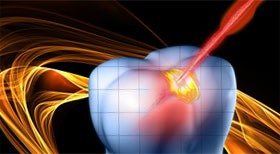
Toothaches caused by cavities can be painful, and the treatment of drilling and filling can be even more painful. As one who fears tooth-aches, using the frequency-domain photothermal radiometry (PTR) and modulated luminescence technology (LUM) in treating cavities before it causes pain is eye-catching. Recently, Health Canada approved a version of this technology to be used in dental offices.
When bacteria in our mouth digest carbohydrates from the foods consumed, they produce acids that demineralize the tooth enamal which causes lesions known as caries, and lead to cavities.  For previous and many current treatments of cavities, dentists drill the cavities out and fill the hole with Amalgam, Gold, special plastic material, or other filling material. X-rays are often used to detect progressed cavities for drilling and filling treatment
For previous and many current treatments of cavities, dentists drill the cavities out and fill the hole with Amalgam, Gold, special plastic material, or other filling material. X-rays are often used to detect progressed cavities for drilling and filling treatment
Dr. Andreas Mendelis and his research team found a way to distinguish the area affected by the lesions before it causes the pain. Lesions have different characteristics compared to healthy teeth enamel in optical and thermal properties. The research team scanned teeth with low-power diode laser energy, and the distinctive luminescence and emitted heat of lesions were detected by an infrared camera. Measuring the reflected light and heat absorbed by the tooth can detect lesions in up to 5mm in depth of the tooth. From then on, reminerlizing solutions, such as flouride is used to restore the lost enamel as stated in Mendelis’ research.
When the laser is shone onto the tooth, the absorbed fraction of the photon after migrating and scattering creates oscillatory temperature field. The oscillatory temperature field is then detected by the photothermal radiometry. Then, the different temperature of lesions and healthy enamel are observed. The modulated luminescence(LUM) is added in detecting lesions. There variation in the lifetime of decaying and healthy part of the tooth, which helps in detecting the lesions.

Laser light being shown onto the tooth. Image from thecanarysystem.com
The difference of this new photothermal radiometry and traditional X-ray is that photothermal radiometry detects lesions in early stages where remineralizing solution can be used, instead of the drilling and filling. Many more benefits come from PTR and LUM treatments, including more accurate results and less painful procedure.
Reference:
http://thecanarysystem.com/pdfs/Publications/2011_March_5_drbicupsid_on_IADR_Meeting.pdf
